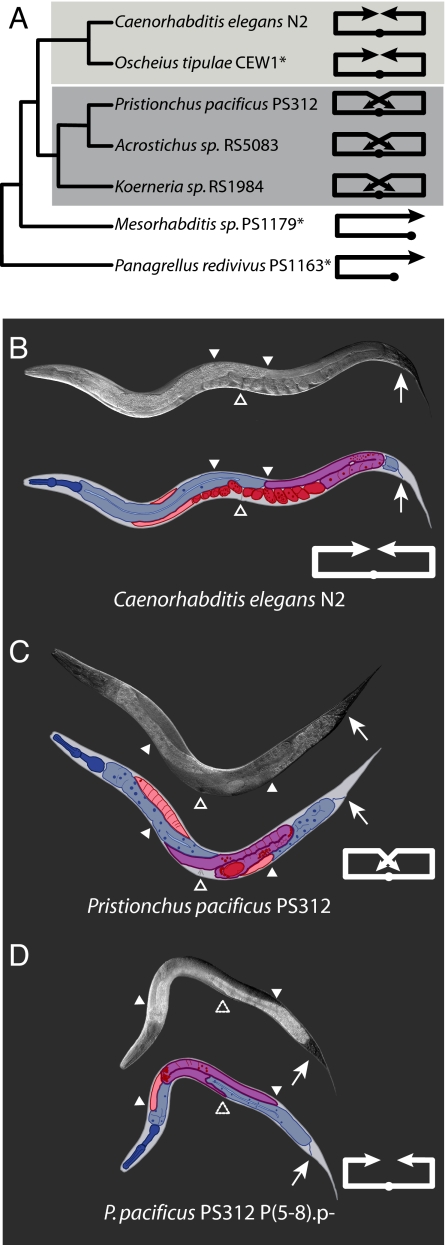Fig. 1.
The gonadal arms of P. pacificus hermaphrodites have a novel ventral arm extension in comparison to C. elegans. (A) Cladogram of nematode species (34). The asterisk indicates data taken for O. tipulae CEW1 from ref. 9, for Mesorhabditis sp. PS1179 from ref. 10, and for P. redivivus PS1163 from ref. 11. Line diagrams indicate the path of hermaphrodite gonadal arm extension, and the solid dot indicates the position of the vulva. The ventral gonadal arm extension is unique to the Diplogastridae. Light gray shading indicates the Rhabditidae family. Medium gray shading indicates the Diplogastridae family. With the exception of Mesorhabditis sp. and P. redivivus, which have monodelphic gonads, all strains are didelphic. However, even in Mesorhabditis sp. and P. redivivus the gonadal arm passes the position of the vulva and does not make a ventral gonadal arm extension. (B–D Upper) Nomarski photographs of animals. (B–D Lower) Color-coded cartoons of the photographs to identify individual tissues: The somatic gonad and germ line are outlined and shaded in tones of purple and red. Purple, one gonadal arm in focus from uterus to distal tip; light red, the other gonadal arm that is mostly out of the plane of focus; red, embryos; small dark red amyboid-like shapes, sperm; solid dark red ovals, representative germ cell nuclei. The digestive tract is outlined and shaded in blue. Dark blue, pharynx; blue, gut; light blue, the lumen of the intestine; navy blue ovals, representative gut nuclei. Solid white triangles denote the distal tip of the gonadal arms. Solid open triangles denote the position of the vulva, i.e., the ventral side of the animal. Dashed open triangles represent the homologous position where the vulva would reside in a wild-type animal; i.e., there is no vulva. Small arrows indicate the position of the anus, i.e., the ventral side of the animal. Line diagrams represent the path of gonadal arm elongation. (B) Wild-type fully adult C. elegans N2 hermaphrodite. (C) Wild-type fully adult P. pacificus PS312 hermaphrodite. (D) P. pacificus PS312 young adult in which the entire vulva has been laser-ablated; i.e., P(5–8).p were killed immediately after hatching. Animals without a vulva must be scored at young adult stage before they fill with embryos and the internal morphology is disturbed.

